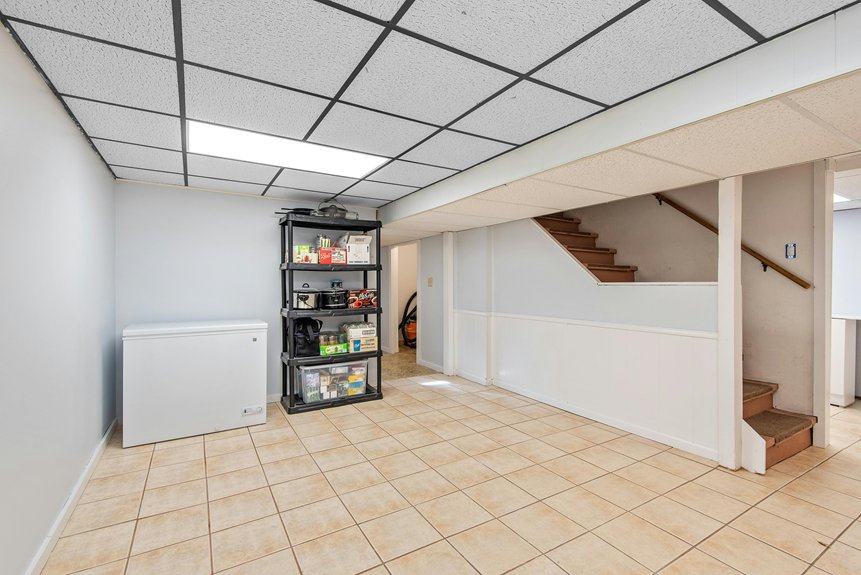When it comes to basement waterproofing in Moorhead, MN, understanding your unique challenges is essential. Factors like groundwater seepage and drainage issues can severely impact your home’s integrity. By evaluating your specific needs, you can determine the most effective interior and exterior solutions available. But before making any decisions, consider the various methods and systems that can guarantee your basement stays dry and healthy. What options will best serve your situation?
Key Takeaways
- Assess your basement’s moisture issues by checking for cracks, damp spots, and humidity levels to determine the appropriate waterproofing solution.
- Choose between interior options like sump pumps and wall sealing, or exterior methods such as drainage systems and waterproofing membranes based on your needs.
- Consider hiring professionals for expert assessments and installations, ensuring long-term reliability and effectiveness against water damage.
- Regular maintenance, including inspections and cleaning gutters, is vital for sustaining your waterproofing system’s effectiveness over time.
- Evaluate the cost of DIY versus professional waterproofing solutions, factoring in the potential savings from avoiding costly water damage repairs.
Understanding the Importance of Basement Waterproofing
When you consider the potential risks associated with a damp basement, it’s clear that waterproofing is essential for protecting your home. High basement humidity can lead to mold growth, structural damage, and compromised air quality.
By investing in professional waterproofing solutions, you’re not just safeguarding your property; you’re enhancing its value. Many companies offer waterproofing warranties, which provide peace of mind and assurance that your investment is protected against future issues.
Don’t underestimate the importance of addressing basement moisture. Taking action now can save you costly repairs later, ensuring a dry, healthy environment for you and your family.
Common Causes of Basement Water Issues in Moorhead
Understanding the common causes of basement water issues in Moorhead is essential for effective prevention and remediation. Here are four primary contributors:
- Heavy Rainfall: Intense storms can overwhelm drainage systems, leading to flooding.
- Common Water Sources: Groundwater can seep in through cracks or openings in your foundation.
- Humidity Levels: High indoor humidity can cause condensation, contributing to dampness.
- Poor Grading: Improperly sloped landscapes direct water toward your foundation instead of away.
Recognizing these factors can help you take proactive steps to protect your basement from water damage.
Assessing Your Basement’s Waterproofing Needs
Identifying the specific waterproofing needs of your basement is essential for maintaining a dry and safe environment.
Start with a thorough moisture assessment to pinpoint areas where water intrusion occurs. This involves checking for damp spots, mold growth, and overall humidity levels.
Next, conduct a foundation inspection to evaluate any cracks or weaknesses that could allow water infiltration. By addressing these issues early, you’ll prevent costly damage and health hazards.
Make sure to document your findings, as this information will help you choose the most effective waterproofing solutions tailored to your basement’s unique conditions.
Don’t wait; act now for peace of mind.
Overview of Interior Waterproofing Solutions
When it comes to preventing water damage in your basement, understanding interior waterproofing solutions is essential.
You’ll discover various types, each with unique benefits that enhance your home’s resilience against moisture.
We’ll also outline the installation process, ensuring you’re well-informed for effective implementation.
Types of Interior Solutions
While many homeowners may overlook the importance of interior waterproofing, it serves as an essential line of defense against moisture intrusion and structural damage.
Here are four key interior solutions to take into account:
- Interior Drainage Systems: These systems redirect water away from your basement.
- Wall Sealing: Using sealants to prevent moisture penetration through your walls.
- Sump Pumps: These actively remove water that accumulates in the basement.
- Dehumidifiers: They maintain ideal humidity levels, preventing mold growth.
Implementing these interior solutions can greatly reduce the risks associated with water damage and protect your home’s foundation.
Benefits of Interior Waterproofing
Investing in interior waterproofing solutions offers numerous benefits that go beyond just preventing water damage.
You’ll experience enhanced moisture control, which not only protects your property but also promotes a healthier living environment. By addressing dampness, you mitigate the risk of mold and mildew, safeguarding your family’s health.
Additionally, interior waterproofing benefits include increased property value and improved air quality, making your basement more usable.
These moisture control solutions are cost-effective investments that pay off in the long run, reducing repair costs and increasing comfort.
Ultimately, interior waterproofing creates a safer, drier space that you can enjoy for years to come.
Installation Process Overview
To effectively harness the benefits of interior waterproofing, understanding the installation process is essential. Here’s a concise overview of the key steps involved:
- Assessment: Inspect your basement for moisture issues and determine the best waterproofing materials.
- Preparation: Clear the area, guaranteeing proper access to walls and floors.
- Application: Apply chosen waterproofing materials using proven installation techniques for ideal results.
- Finishing Touches: Seal any gaps and guarantee proper drainage to prevent future water intrusion.
Exploring Exterior Waterproofing Methods
When it comes to protecting your basement, exploring exterior waterproofing methods is essential.
Implementing a drainage system, applying waterproofing membranes, and making grading adjustments can greatly enhance your home’s defense against water intrusion.
These proactive measures not only safeguard your property but also improve its overall value and longevity.
Drainage System Installation
As moisture accumulation can lead to significant structural damage over time, installing a proper drainage system around your home is essential for effective exterior waterproofing.
Here’s a quick guide to guarantee you have a solid drainage design:
- Assess your property’s topography for ideal drainage flow.
- Choose the right type of drainage system, such as French drains or surface drains.
- Confirm proper installation to avoid future blockages.
- Schedule regular drainage maintenance to keep your system functioning efficiently.
Waterproofing Membrane Application
After ensuring your drainage system is in place, applying a waterproofing membrane can greatly enhance your home’s protection against moisture.
This method utilizes advanced waterproofing techniques, ensuring a seamless barrier against water infiltration.
You can choose from various membrane materials, such as liquid-applied membranes or sheet membranes, each offering unique benefits.
Liquid membranes provide flexibility and ease of application, while sheet membranes offer durability and resistance to punctures.
By investing in a quality waterproofing membrane, you not only safeguard your foundation but also improve your home’s overall value.
Don’t compromise on protection; choose the right membrane for your needs today.
Grading and Landscaping Adjustments
To effectively prevent water from pooling around your foundation, proper grading and landscaping adjustments are essential.
Here are four key steps to take into account:
- Soil Grading: Make sure the ground slopes away from your foundation to direct water flow.
- Install Drainage Systems: Utilize French drains or surface drains to manage excess water effectively.
- Maintain Landscaping: Keep shrubs and trees away from your foundation, as their roots can disrupt drainage.
- Regular Inspections: Frequently check your grading and drainage systems to identify any issues early.
The Role of Sump Pumps in Basement Protection
While many homeowners underestimate the importance of a sump pump, it plays an essential role in protecting your basement from water damage.
Proper sump pump installation guarantees that water is efficiently removed, preventing flooding and structural damage.
Regular sump pump maintenance is vital to keep the system functioning at its best. This includes checking the pump’s operation, cleaning the sump pit, and replacing any worn components.
Investing in a reliable sump pump and committing to its upkeep can save you from costly repairs and preserve your home’s value.
Don’t wait until it’s too late—make sure your basement stays dry and safe with a sump pump.
Choosing the Right Drainage Systems
Choosing the right drainage system is essential for preventing water accumulation in your basement, especially if you live in an area prone to heavy rainfall or flooding.
Understanding various drainage system types will help you select effective drainage solutions. Consider these options:
- Interior French Drains: Redirect water away from your basement.
- Exterior French Drains: Manage surface water before it reaches your foundation.
- Grading: Guarantee proper slope away from your home.
- Channel Drains: Collect water in high-risk areas, like driveways.
Cost Considerations for Waterproofing Your Basement
When you’re considering basement waterproofing, understanding the costs involved is essential for making informed decisions.
DIY waterproofing can save you money upfront, but it often requires time, effort, and a solid understanding of techniques to be effective.
On the other hand, professional services may seem pricier, yet they guarantee expert results and long-term reliability.
Weigh the initial investment against the potential for costly water damage down the line.
Ultimately, choosing the right approach depends on your budget, skill level, and the severity of your basement issues.
Consider both options carefully to protect your home effectively.
Maintenance Tips for Long-Lasting Waterproofing Solutions
Investing in waterproofing your basement is just the first step; maintaining those solutions is key to guaranteeing their longevity and effectiveness.
Waterproofing your basement is just the beginning; ongoing maintenance ensures lasting protection and effectiveness.
To keep your basement dry, follow these maintenance tips:
- Conduct routine inspections for cracks or leaks.
- Clean gutters and downspouts regularly to direct water away.
- Guarantee proper grading around your foundation for effective drainage.
- Implement preventive measures, like installing sump pumps or dehumidifiers.
Conclusion
In Moorhead, MN, effective basement waterproofing is essential for protecting your home from water damage and maintaining a healthy living space. By understanding common water issues and evaluating your specific needs, you can select the right combination of interior and exterior solutions, including sump pumps and proper drainage systems. Investing in reliable waterproofing not only enhances your property’s value but also prevents costly repairs down the line. Don’t wait—secure your basement today for peace of mind tomorrow.

